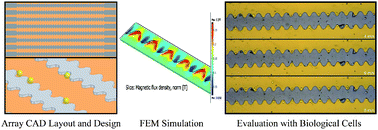A novel permalloy based magnetic single cell micro array
Abstract
Devices capable of automatically aligning cells onto geometrical arrays are of great interest to biomedical researchers. Such devices can facilitate the study of numerous cells while the cells remain physically separated from one another. In this way, cell arrays reduce cell-to-cell interactions while the cells are all subjected to common stimuli, which allows individual cell behaviour to be revealed. The use of arrays allows for the parallel analysis of single cells, facilitates data logging, and opens the door to the use of automated machine-based single cell analysis techniques. A novel permalloy based magnetic single cell micro array (MSCMA) is presented in this paper. The MSCMA creates an array of magnetic traps by generating magnetic flux density peaks at predefined locations. When using cells labelled with immunomagnetic


 Please wait while we load your content...
Please wait while we load your content...